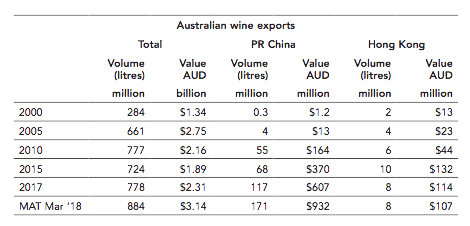It is decidedly curious that the picture most frequently painted is of a vibrant export market and flat domestic sales in a tough, competitive environment. Dealing with the latter first up, in the 2017 financial year the sales volume rose 2% to 500 million litres, with value up 6% to $3.3 billion. Consumers are paying more for each litre sold, and buying more. The budget – and the various reports of consumer confidence – suggests the market should be in fine fettle. But talk to sales reps and independent retailers, and they all say it’s tough out there.
There are few frowns on the faces of exporters, and only broad smiles on the faces of Treasury Wine Estates’ shareholders, with the share price almost touching $20 at the time of writing. The People’s Republic of China insists that Hong Kong and Macau are part of its territory; combined sales in these three regions reached $1 billion for the 12 months to 31 March 2018.
While the value per litre of Australian wines is the highest of the top five exporters to China, with France in second place, there has been solid growth across all price sectors. Research conducted by Wine Intelligence on behalf of Wine Australia shows that the number of Chinese drinkers of Australian wine has doubled since 2013.
This increase reflects the solid growth in entry level and commercial wines retailing for less than ¥60 (approximately AUD $13) per bottle. The increased accessibility of imported wine in China means that it is becoming a mainstream beverage enjoyed by a much broader base of consumers, and a beverage of choice for informal meals and relaxing at home. A further indication of this is the increase in sales of white wines, up 33% to $30 million for the 12 months to 31 March 2018. Chardonnay is the number one variety, but riesling was up 77% at twice the rate of increase as chardonnay.
The market share of each of the major exporters to China for the moving annual total (MAT) February 2018 shows that Australia continues to narrow the gap between itself and France, and widen the gap between itself and Chile. France and Australia supplied 65% of all wine imported by China in the 12 months to February 2018.




